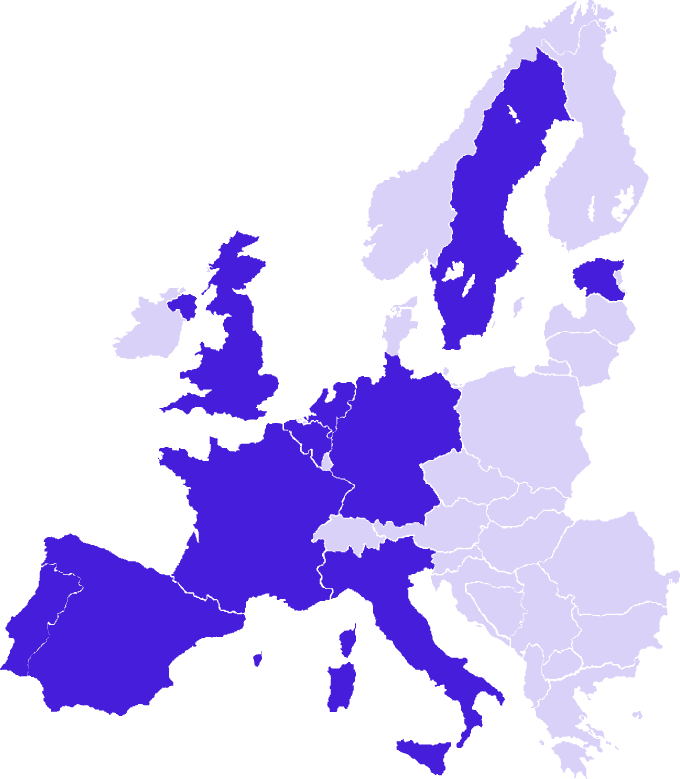Outputs
Factsheets & Overview
OPTIMA Overview –
for Patients
What?
OPTIMA is a group of participants from different areas, such as doctors, researchers, patients and patient advocates, who are working together for a common goal. They want to make sure that every patient with breast, lung or prostate cancer gets the best and most personalised treatments available. They also want to bring new and exciting therapies to help people get better.
Where?
in Europe
Who?
Other European Commission funded projects (PIONEER, EHDEN, HARMONY, DARWIN, EHDS), Medical societies such as ERS, ESMO, and EAU, Patient advocacy groups and organisations – for patients and with patients, academic partners, small and medium sized companies, Pharmaceutical companies
Why?
In a nutshell, the project aims to create a user-friendly platform that collects and analyses cancer data to improve patient care and support doctors in making better treatment decisions.
Our goal is to create a user-friendly and privacy-friendly platform in Europe that gathers data about cancer treatment and evidence. This platform will be designed with the input of doctors and patients, and it will be inclusive and sustainable.
We will collect and organise large amounts of real-life data on cancer patients to build a comprehensive catalogue of information.
The platform will be secure and valuable. It will allow doctors to use tools such as artificial intelligence to help them make better decisions based on guidelines.
Our focus will be on three types of cancer: prostate, breast, and lung cancer, and we will create tools to support doctors and patients in making decisions about treatment for these cancers.
The platform will be continuously updated with the latest knowledge and advances in cancer treatment.
For Whom?
OPTIMA has a plan to create a special platform that considers what doctors and patients really need. They want everyone to be involved in this project, and they want it to last a long time. The goal is to use this platform to help doctors and patients work better together. They’ll use advanced data and technology, such as artificial intelligence, to make better decisions about healthcare together.
How?
Objectives
To find and understand the most important questions that need to be answered through research about breast, prostate and lung cancer
- Figure out the most important questions that need to be answered through research
- Rank and highlight the most important guidelines and recommendations that doctors should follow at each step of cancer treatment for each stage of the cancer care journey
- Create a helpful tool called a ‘guideline-based decision support tool‘ which will be a part of the OPTIMA platform. This tool will be used in hospitals and clinics, and it will connect with their computer systems. It will quickly provide doctors with useful recommendations as they care for patients
- Find out what might make it easy or difficult for doctors to use the tool in their everyday work with patients
- Check if doctors are following the guidelines for treating patients
Main Output
Guidelines based support decision tool connected to data platform
Objectives
To fill the missing information in the current guidelines that doctors use for treating patients
Activities
- Collect and combine information from different types of studies and real-life experiences of patients
- Organise the data and make sure it’s ready to be used
- Make sure the methods we use to study this data are reliable and can give us trustworthy information about how treatments work in real-life situations
- Using the power of Artificial Intelligence (AI), we want to make the guidelines even better
- Create models with AI that can be added to the tools doctors use to follow the guidelines
- This will help doctors make better decisions for each patient by filling in the missing parts of the guidelines
- We will use AI to figure out what individual factors affect how well a patient does with cancer treatment and their overall well-being
- We want to find hidden connections between different types of information that could help improve how well cancer patients do and how they feel
- By doing this, we can help doctors make better decisions based on strong evidence, using different kinds of data and regularly checking how well things are going
- To make it easier to understand and use, we will include helpful explanations in the tool that doctors use to follow the guidelines. These explanations will come from AI techniques
Main Output
Enhance the quality of treatment and care decisions for patients
Objectives
To create, put into action, customise and assess the OPTIMA platform
Activities
- Figure out the requirements and needs for all the OPTIMA users
- Create the first version of the platform with all the necessary features
- Create a security framework to protect the data and operations from any potential risks
- Carefully review how doctors and other users use the platform and adapt it based on the user feedback
Main Output
Personalised and user friendly OPTIMA platform
Objectives
To make sure that everything we do with the OPTIMA platform follows all the legal rules and ethical guidelines
- Make sure to treat patients and their personal data with respect and follow all the legal and ethical rules in the project
- Carefully design the AI tool and data platform to meet all the legal and ethical standards
- Set up a structure within the project to protect patients’ personal data and ensure it is handled properly
Main Output
OPTIMA data, platforms, tools and AI follow the legal and ethical requirements

